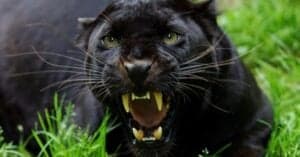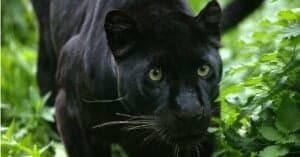A panther is a dark-colored variation of a wild cat species, commonly a jaguar or leopard. They live in wetlands, grasslands, and forests and are dark brown or black. These creatures are hard to find, sneaky and solitary animals. Therefore, humans rarely have close contact with them. Panthers are skilled hunters that hunt medium-to-large-sized herbivores with excellent jumping, climbing, and sprinting abilities. There are many fascinating panther facts to learn about these majestic and elusive beasts. There are a lot of questions about panthers, probably because of their mysterious and stealthy nature.
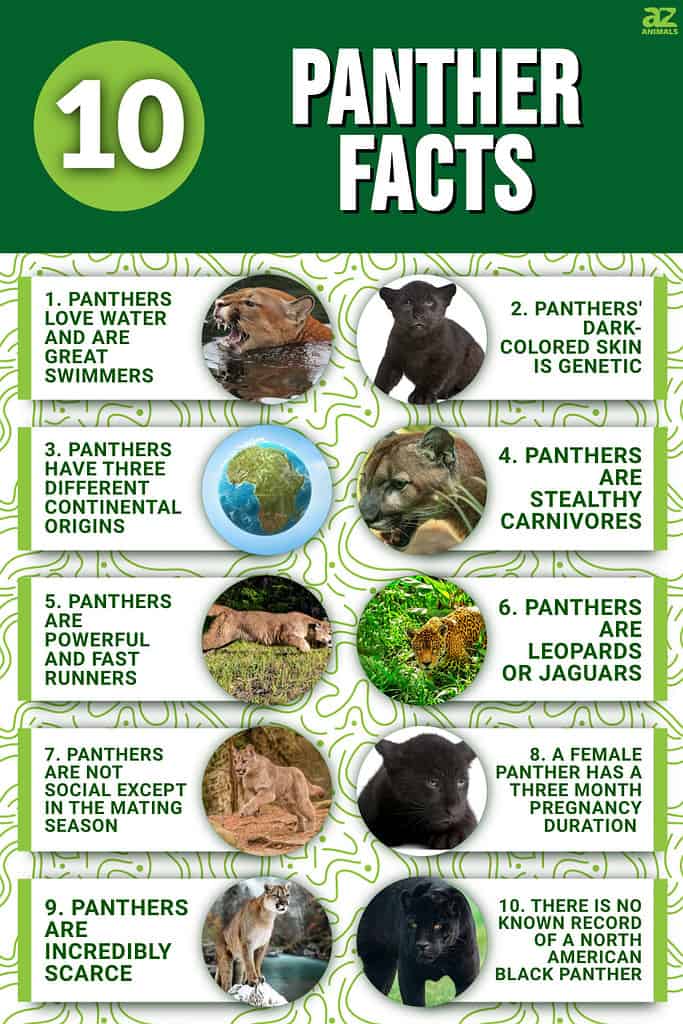
Some of those questions might be answered by the following facts about panthers. Let’s go!
1. Panthers love water and are great swimmers
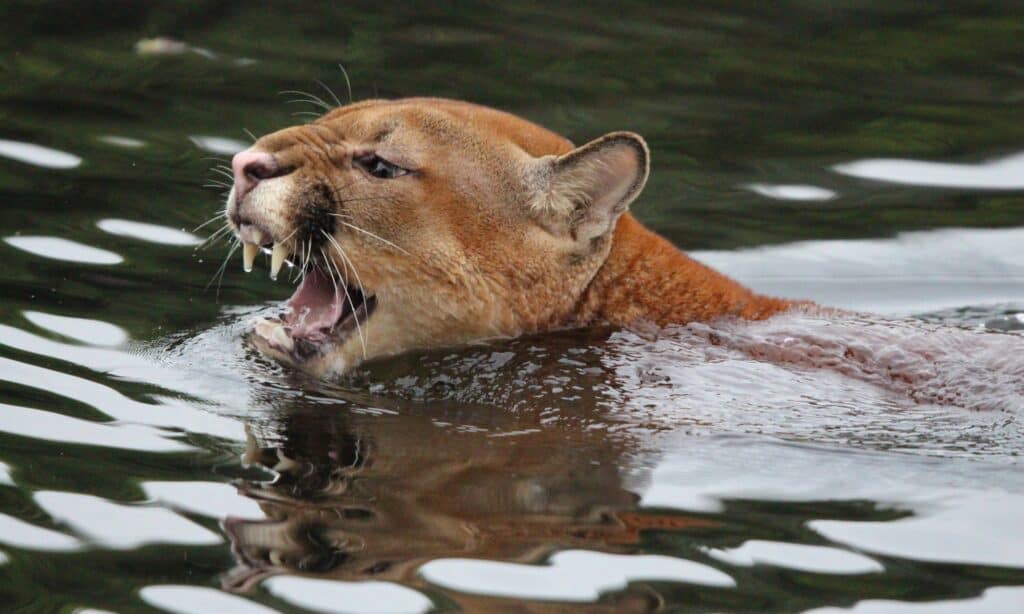
Panthers enjoy the water compared to most domesticated pet cats and Panthera pardus.
©iStock.com/Shannon Mullen
Among the most impressive panther facts is how well these animals enjoy the water compared to most domesticated pet cats and Panthera pardus, a descendant of leopards that dislike water. On the contrary, the Panthera Onca has a very different tale. These species enjoy swimming and choose swampy wetlands and flooded forests as their most preferable habitats. However, panthers also spend much time playing, relaxing, and chilling in the water.
2. Panthers’ dark-colored skin is genetic

Panther cubs are really leopard or jaguar cubs, just with unusual black fur.
©Eric Isselee/Shutterstock.com
If they could, black panthers would be grateful for melanism as an evolutionary process. It demonstrates that darker members of this species are more prone to survival, escaping predators through camouflage, living long, and reproducing because they are better hidden. This is especially true in some natural settings, such as densely forested areas with minimal light, where melanism is more prevalent. Melanism is therefore passed down through a dominant gene in the Panthera Onca (a panther that evolved from the species of a jaguar). This means that black jaguars can have black or spotted cubs, but normal jaguars can only have spotted cubs.
3. Panthers have three different continental origins

In Asia and
Africa
, black leopards are more prevalent.
©leolintang/Shutterstock.com
Panthers originate from different big cat species, so there are many distinct panther facts about the surroundings in which they can live. The three main continents of origin include Africa, Asia, and South America. In Asia and Africa, black leopards are more prevalent. They live in densely forested places, like the African mountain slopes and tropical forests in Malaysia, Nepal, Indonesia, and China. However, black jaguars enjoy damp lowlands, rainforests, and savannahs. They are primarily found in places like the Amazon forest in Central America.
4. Panthers are stealthy carnivores
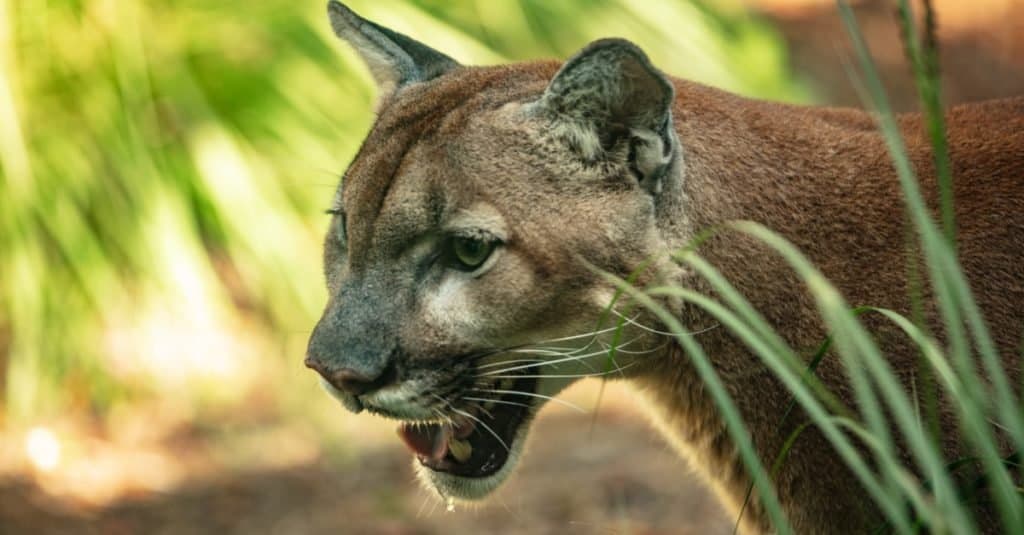
Panthers hunt at night because they are nocturnal animals.
©J.A. Dunbar/Shutterstock.com
Panthers naturally eat small to average-sized herbivores, which makes them carnivores. Nevertheless, the species of animals they eat depends on the area in which they live. They feed on a wide variety of animals, including deer, rabbits, antelopes, warthogs, wild boars, and birds. Panthers have numerous characteristics that relate to their fearsome hunting abilities. One of the most distinguishing characteristics of these stealthy creatures from other big cats is their ability to blend in stealthily. Panthers hunt at night because they are nocturnal animals. Aiding their hunting is the presence of dark fur, letting them blend into their surroundings, and their keen vision and sensitivity to smell aid in detecting prey. Although panthers prefer to hunt and forage on the ground, they also ambush animals from trees.
5. Panthers are powerful and fast runners

Panthers use their great speed to chase down their prey.
©Holly S Cannon/Shutterstock.com
Numerous panther facts combine to make them formidable predators. In addition to their ability to blend in, panthers can achieve a run-up of 35 miles per hour, which helps them catch up with quick prey like antelope and deer. Panthers are also quite agile, leaping up to twenty feet to catch up on their prey. One more unusual (for other cats) fact about panthers is that they can climb. Panthers are among the best climbers of all the big cats. They take advantage of trees all the time, whether for hiding, spying, or ambushing their game. Furthermore, their powerful jaws allow them to drag prey into tree branches.
6. Panthers are leopards or jaguars
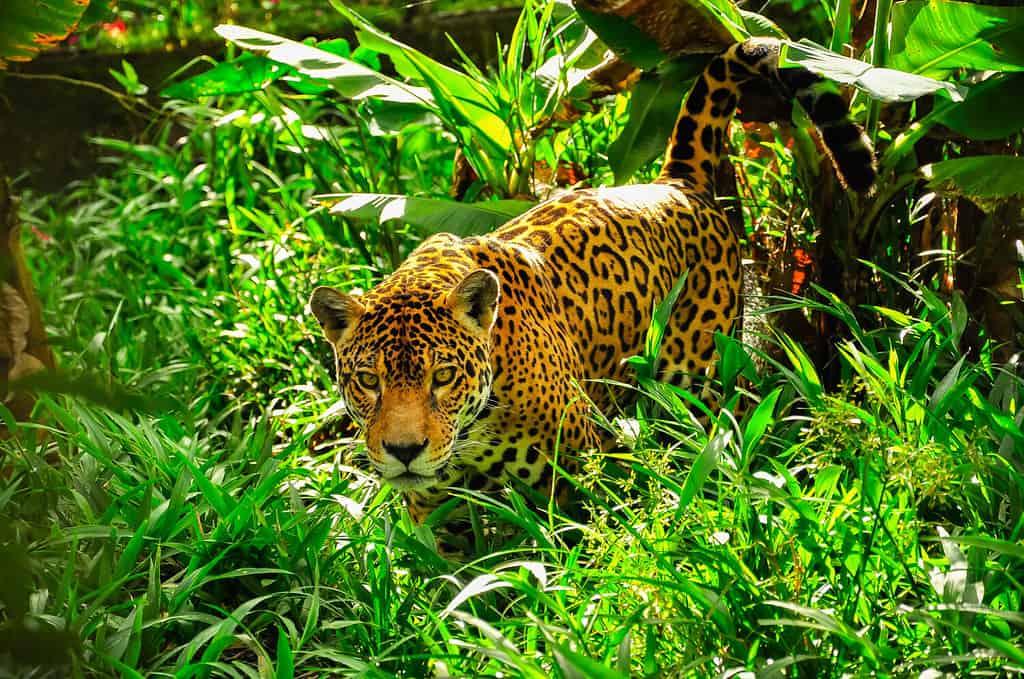
Panthers are typically leopards or jaguars.
©Jo Reason/Shutterstock.com
A vast majority seem to misinterpret even the most simple facts about panthers. People generally think of panthers as an entirely distinct species of cat. However, on the contrary, depending on the geographical area, panthers are typically leopards or jaguars, depending on the geographical location. This is because panthers are characterized as a dark-colored (melanin) variation of other Panthera genus species such as lions, leopards, jaguars, and tigers. Melanism refers to the formation of a pigment (usually of a dark color) in the skin. Hence, this color variety generally indicates the cat is black or dark brown. You can read up on the differences between panthers and jaguars.
7. Panthers are not social except in the mating season

The female panther reaches sexual maturity at the age of two years.
©Vaclav Sebek/Shutterstock.com
There are several fascinating facts about panthers’ behavior, even in their habitat. Panthers are solitary creatures that prefer to hunt, travel, and live alone. The only time this rule does not apply would be when it’s time to mate. When ready to mate, adult female panthers leave a scent and trail for the male to track. She also makes a squeaking sound to notify the male of her location. They hardly stay with each other for more than a couple of days after mating. The female panther reaches sexual maturity at the age of two years and gives birth to her first litter at around two and a half years. The adult male panther is likewise sexually matured at two but rarely gets the opportunity to mate due to pressure, threats, and fierce competition for females between older males.
8. A female panther has a three month pregnancy duration
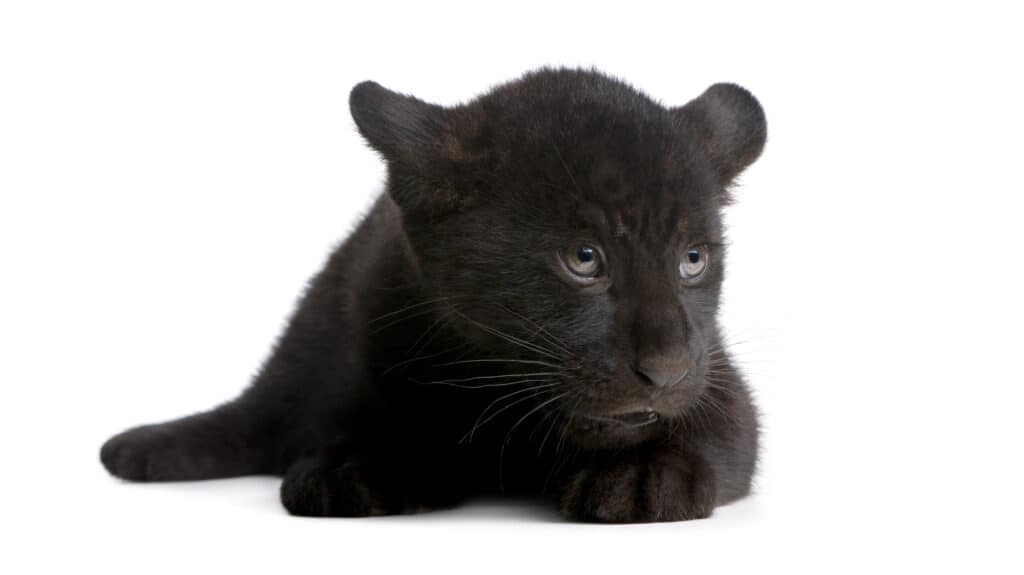
Panther cubs are really leopard or jaguar cubs, just with unusual black fur.
©Eric Isselee/Shutterstock.com
A female panther’s gestation cycle is about three months, and she gives birth to a litter of up to four cubs. Panthers bear children in a secure den most of the time. The male has no involvement in the upbringing of cubs, who spend approximately two years with their mother panther. Apart from the fact that cubs do not see in the earliest days (two weeks) of their existence, they are also weak and vulnerable when they are young. Predatory assaults on the den, especially when the mother panther is out foraging, can jeopardize their lives during this period. The cubs, however, can follow their mother after a few months. One of the most amazing facts about panthers is how rapidly these baby panthers learn.
9. Panthers are incredibly scarce
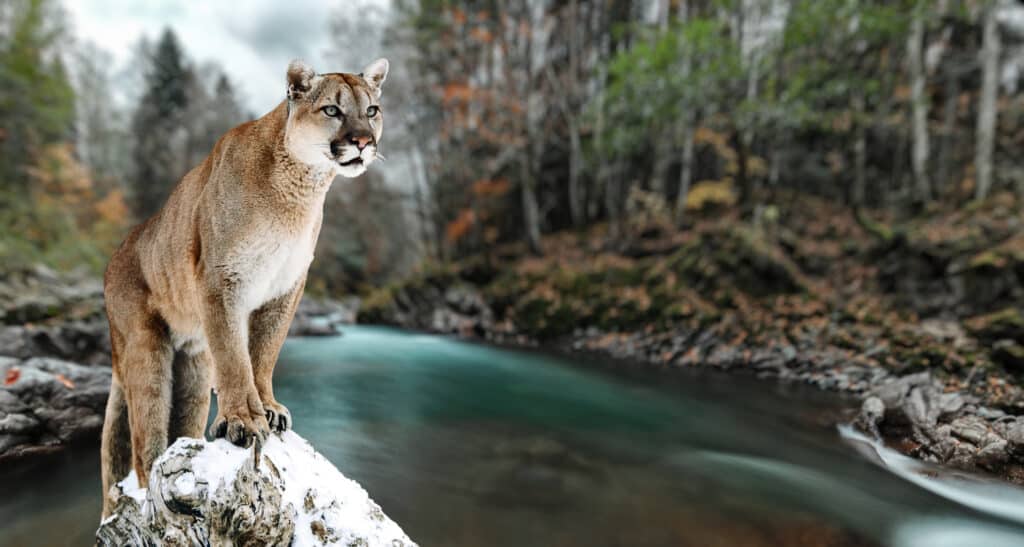
©Evgeniyqw/Shutterstock.com
One of the most worrying truths about panthers is that they are incredibly scarce. This is due to genetics and because these exquisite animals and their homes have been increasingly threatened in recent years. Many human activities, including deforestation, are drastically limiting the quantity of available habitat for these large cats. Furthermore, panther hunting for fur or other prizes has resulted in a significant fall in their populations, as well as those of normal jaguars and leopards. Panthers have become so scarce and elusive that people seldom see them. As a result, they’ve earned the nickname “forest ghosts.” Panthers are presently deemed endangered, even though they still exist.
10. There is no known record of a North American black panther
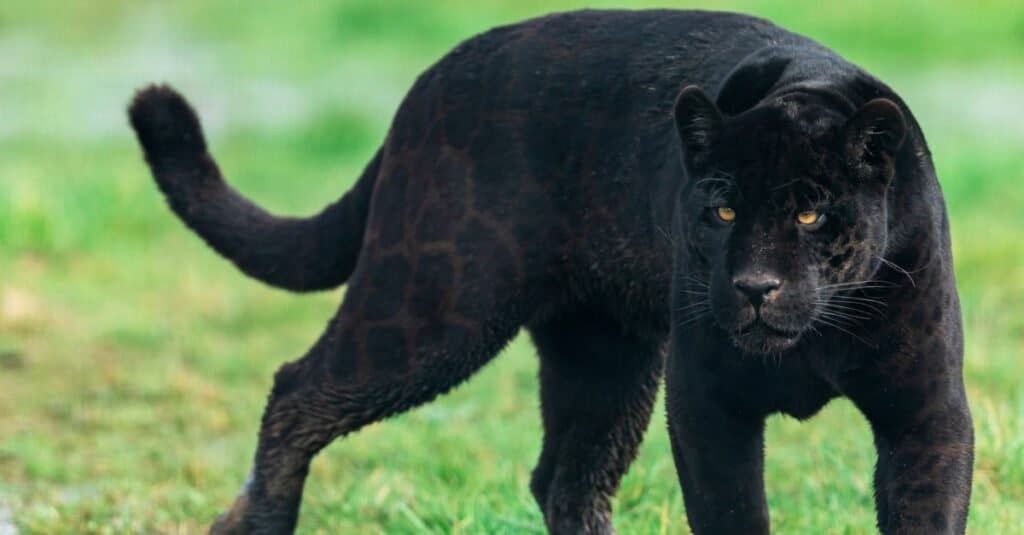
The North American black panther is classified as a cryptid.
©AB Photographie/Shutterstock.com
As many fascinating facts as there are about panthers, these dark, stealthy animals also generate a lot of controversies. Many encounters with black cats have been reported throughout history in North America, which some people believe are melanistic (dark-colored) cougars. In North America, however, neither mountain lions nor black cougars have been caught, shot, seen, or bred. Therefore, experts concur that they’re non-existent. Any related stories are attributable to a mix-up in identity or a misinterpretation of the animals’ size. In response to this, the North American black panther is classified as a cryptid, or a creature whose presence is yet to be verified.
The photo featured at the top of this post is © jo Crebbin/Shutterstock.com
Thank you for reading! Have some feedback for us? Contact the AZ Animals editorial team.




